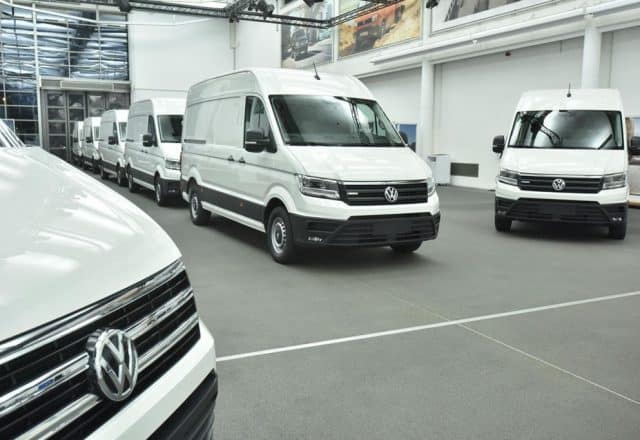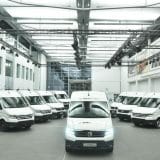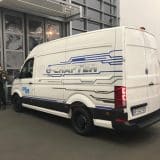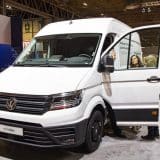Pros:
- Comfortable ride
- Low running costs
- Quality interior
- Safety kit
Cons:
- Price
The Volkswagen e-Crafter shows skills
While it’s the biggest van from Volkswagen, the e-Crafter is an impressive offering. The latest conventional model was relaunched in 2017 and was a big step forward when compared with its predecessor; the e-Crater is essentially a step further on from this. This means in a competitive market, the VW e-Crafter will meet a wide range of needs with a quality, well-made van offering rock bottom running costs – these will be from just 2p per mile.
Volkswagen has also taken a long time in bringing this all-electric van to the marketplace and it’s been tested thoroughly with a range of fleet clients to ensure it meets the real world demands that such a van will require. It helps too that the German manufacturers have taken time to consult with potential buyers to ensure they get the offering just right and this is just the right creation to tap into a potentially big market.
However, there’s still confusion over when the e-Crafter will reach our shores. European testing with customers ended in late 2017 while in the UK extra testing took place in May 2018. The VW e-Crafter is scheduled for a September 2018 launch but there are worries that the UK may not get a right hand drive version until 2020 – or even 2021. That would be a shame since the UK is a big market for vans and the demand for all-electric vehicles is growing quickly. When it does eventually arrive, the VW e-Crafter will be a sound choice with a lot to offer those who invest in one.
Reasons to buy
The Volkswagen e-Crafter is a cracker is aimed at those van owners who travel up to 60 miles every day with lots of stops and starts. VW says that these parameters account for around 85% of all deliveries made in cities and towns. The Volkswagen e-Crafter is just as comfortable to drive with lots of technology as its conventional engine sibling with the option of low running costs, from as little as 2p per mile. These factors really do make this an attractive proposition. And, let’s face it, with growing numbers of cities looking at introducing congestion charging, more fleet operators will be looking at low emission vans.
If you like the Volkswagen e-Crafter then have a look at the Nissan e-NV200.
Running Costs
Since the battery-powered Volkswagen e-Crafter will need its battery recharging when necessary, the running costs are an incredible 2p per mile. It may be that as a large electricity user, the van operators can access lower charges while others could utilise solar panels to boost their savings. With a growing network of quick charging stations available in the UK, these can be used to recharge the battery to 80% of its capacity in 45 minutes.
Charging from a wall box to 100% takes around 5.5 hours, which is much quicker than many of its rivals. This wall box cost should also be considered if the e-Crafter appeals.
Load Space
The Volkswagen e-Crafter’s lithium ion battery has been integrated into the underbody completely so the van’s entire 10.7 m³ of load space is fully usable. The e-Crafter is capable of carrying a payload of between 1 tonne and 1.75 tonnes. The van’s electronics are under the bonnet where the engine would normally be.
Technology & Safety
From launch, the new Volkswagen e-Crafter will have a range of convenience and driver assistance systems and lots of standard kit. The e-Crafter will have as standard equipment a multifunctional camera that features a rearview camera system along with parking assist and protection system.
There’s also heated seats, satnav, automatic climate control, LED headlights. VW has yet to confirm the final spec for the UK version of e-Crafter but the overall offering will be impressive.
Performance
The Volkswagen e-Crafter delivers all of its power without any drag once the accelerator is depressed and this is applied smoothly and quietly; around town the van is agile and comfortable to be in. Also, on long journeys, drivers will find the all-electric power is impressive and while the top speed is limited to 55 mph it should deliver a range of around 100 miles. For most operators that will suffice and even in the depths of winter when more electrical equipment is being used, the real world range being achieved will still be 80 miles at least – VW promises! The 100kW electric motor delivers plenty of power – the equivalent of 136hp – which makes this one of the most interesting van launches for some time.





